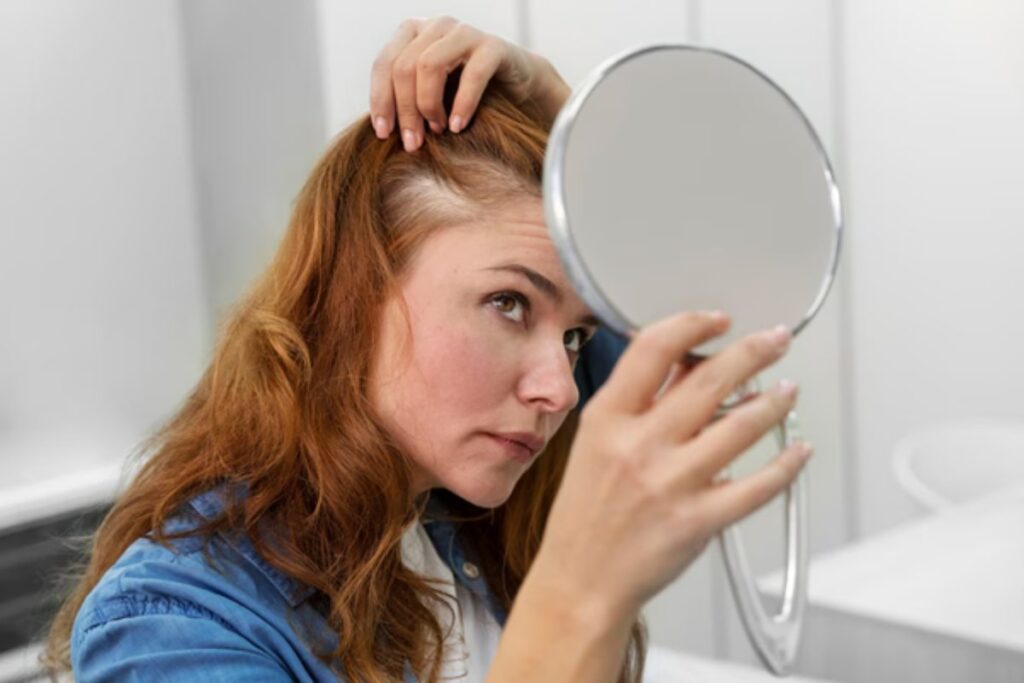Scarring alopecia, also known as cicatricial alopecia, presents a unique challenge in terms of treatment, especially for women. This condition involves the destruction of hair follicles and subsequent scarring, leading to irreversible hair loss. While there’s no definitive cure for scarring alopecia. Several treatment approaches aim to manage symptoms and potentially slow down its progression.
Understanding Scarring Alopecia

What is Scarring Alopecia?
Scarring alopecia is a kind of hair loss characterised by the permanent destruction of hair follicles and subsequent scarring of the scalp tissue. This leads to irreversible hair loss and can affect both men and women.
Types of Scarring Alopecia
There are several subtypes of scarring alopecia, including lichen planopilaris, frontal fibrosing alopecia, and central centrifugal cicatricial alopecia, each with its own unique characteristics and presentation.
Causes of Scarring Alopecia
The exact cause of scarring alopecia is not fully understood, then it is believed to involve a combination of genetic, autoimmune, and inflammatory factors. Certain medical conditions and medications may also contribute to the development of scarring alopecia.
Signs and Symptoms
Identifying Scarring Alopecia
Scarring alopecia often presents with a gradual onset of hair loss accompanied by itching, burning, or pain in the affected scalp areas. Over time, the hair loss progresses, and the scalp may develop visible scars and changes in skin texture.
Common Symptoms in Women
In women, scarring alopecia can manifest as diffuse thinning of the scalp hair, widening of the part line, and a receding hairline. Some women may also experience hair loss in other body areas, such as the eyebrows or eyelashes.
Medical Diagnosis

How is Scarring Alopecia Diagnosed?
Diagnosing scarring alopecia typically involves a thorough medical history, physical examination, and sometimes, additional tests such as scalp biopsies or blood work to rule out other possible causes of hair loss.
Importance of Medical Evaluation
It’s crucial for women experiencing hair loss to seek medical evaluation by a dermatologist or healthcare provider experienced in diagnosing and treating hair disorders. Early diagnosis and interference can help prevent further hair loss and improve treatment outcomes.
Treatment Approaches
Topical Corticosteroids
Topical corticosteroids are usually used as a first-line treatment for scarring alopecia to reduce inflammation and halt the immune system’s attack on hair follicles. These medications come in various strengths and formulations and are applied right to the affected scalp areas.
Intralesional Corticosteroid Injections
For more severe cases of scarring alopecia, corticosteroids may be injected directly into the scalp lesions to deliver a more targeted dose of medication and reduce inflammation.
Systemic Corticosteroids
Oral corticosteroids may be prescribed for widespread or rapidly progressing scarring alopecia to suppress the immune response and reduce inflammation throughout the body. However, long-term use of systemic corticosteroids can lead to significant side effects and must be carefully monitored.
Topical Immunotherapy
Topical immunotherapy involves applying chemicals such as Diphencyprone (DPCP) or squaric acid dibutyl ester (SADBE) toward the scalp to induce an affected reaction. This reaction can help modulate the immune response and potentially stimulate hair regrowth in some cases.
Antimalarial Medications
Certain antimalarial medications. Such as hydroxychloroquine or chloroquine, have shown promise in treating specific types of scarring alopecia by reducing inflammation and suppressing the immune system.
Antibiotics or Antifungal Medications
If there’s evidence of bacterial or fungal infection contributing to the inflammation in scarring alopecia, antibiotics or antifungal medications may be set to address these underlying issues.
Surgical Interventions
In cases where scarring is extensive and irreversible, surgical choices such as hair transplantation or scalp reduction may be careful to restore hair density and improve cosmetic appearance.
Supportive Therapies
Alongside medical treatments, supportive therapies such as camouflage techniques (like wigs or hairpieces), counselling, and provision groups can assistance women cope with the emotional impact of hair loss and maintain their self-esteem.
Conclusion

Scarring alopecia poses a significant challenge for women, but with early diagnosis and appropriate treatment, it’s possible to manage symptoms and advance quality of life. By working closely with a dermatologist or healthcare provider experienced in treating scarring alopecia and other hair loss disorders, women can explore various treatment options and develop personalised strategies to address their specific needs.
In addition to seeking early diagnosis and treatment, women with scarring alopecia can take proactive steps to support their overall well-being. This may include adopting a healthy life that encompasses balanced nutrition, regular exercise, and stress management techniques. Engaging in activities that promote reduction and mindfulness can help mitigate the emotional impact of hair loss and foster a positive mindset. Furthermore, connecting with support groups or online societies of individuals facing similar challenges can provide invaluable emotional support and practical advice. Sharing skills and learning from others who have navigated the journey of living with scarring alopecia can instil a sense of camaraderie and empowerment.
It’s also important for women to communicate openly with their healthcare providers and actively share in decision-making regarding their hair loss treatment for women. By voicing their concerns, preferences, and goals, women can collaborate with their medical team to tailor treatment methods that align with their individual needs and lifestyle. Ultimately, while scarring alopecia may present challenges, it’s essential for women to focus on nurturing their overall well-being and embracing their unique beauty beyond physical appearance. With a holistic approach to self-care and a supportive network of healthcare professionals and peers, women can navigate the complexities of scarring alopecia with resilience and grace, reclaiming their confidence and living life to the fullest.

